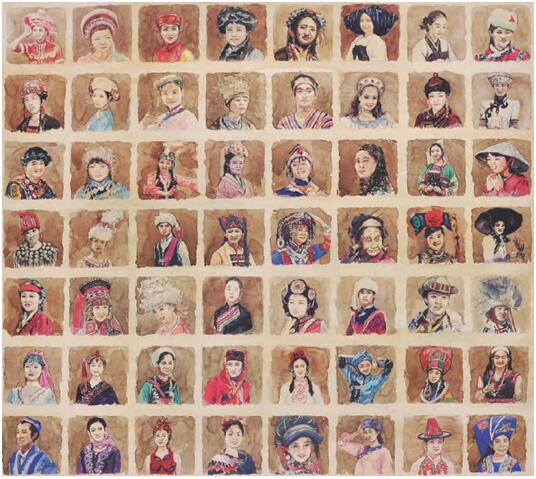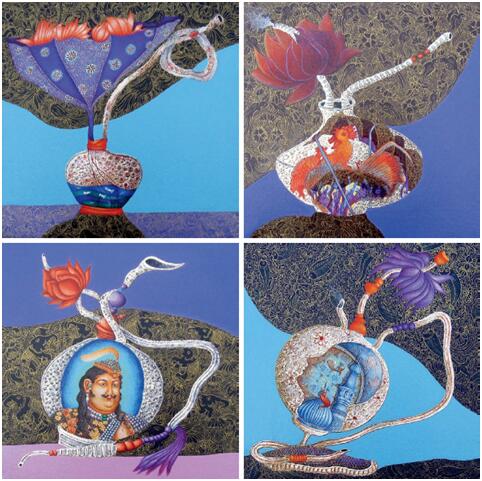
Shao Wenda(China)
Harmony / 2013 / watercolor / 100cm×90cm
Works of the 6th Beijing Biennale, 2015
The Venice Biennale, founded in Italy in 1895, was the original international art biennale which is modeled by other countries elsewhere in the world, especially by the Western countries. In 1951, the S?o Paulo Art Biennial was founded in Brazil which is the first biennale in developing countries. In 2002, after the tradition of international art biennales, we established the Beijing International Art Biennale (the Beijing Biennale for short) of our own co-founded by China Federation of Literary and Art Circles, the Government of Beijing Municipality and China Artists Association. For the last fifteen years, we have held seven editions of the Beijing Biennale. From the first edition in 2003 to the current one, the participating countries have grown from 45 to over 100 with the accumulated number of artists at home and abroad reaching about 4000 and the audience over one million. As for the 7th Beijing Biennale this year, the countries involved have outnumbered any other international art biennales ever held around the world. All these are a testimony to the fact that though with a late start, the Beijing Biennale develops fast. Our curatorial team has been to the Venice Biennale, the S?o Paulo Art Biennial and others to learn from their experience but we didn’t completely copy their models. Instead, we gradually formed our own pattern—the China model featuring both international vision and local characteristics.
What is unique about the China model of the Beijing Biennale first is its collective planning system with the works to be presented coming from invitation and selection alike. The Biennale didn’t follow the planning practice of leaving all to one man’s decision which is commonly used by the West but applies a collective planning system: the curatorial team is constituted by curators, critics and artists both from China and abroad, and “democratic centralism” is carried out at any stage from theme planning to work selection. As for planning by the individual and planning by the collective, each has its advantages and disadvantages. But to the Beijing Biennale, it has been proved that the collective planning system plays a positive role in most cases and, it is still undergoing improvement to make sure the team is streamlined, optimized, more professional and younger in age. In terms of the sources of artists, at the Venice Biennale or the S?o Paulo Art Biennial, in general artists are specifically invited by the curators, while at the Beijing Biennale, participating artists are not only from invitation but also from selection. By inviting certain artists can the theme of the Biennale be well interpreted and the quality of art be ensured; and by opening the gate to the common artists especially the young artists can we broaden the scope and provide a fair opportunity for them to stand out.
The China model of the Beijing Biennale is also characterized by its planning concept with its concentration on the critical issues of common concern in the contemporary world, which advocates communication and dialogue between the Eastern and Western civilizations and the idea of building a harmonious world. The themes of the Biennale—“Originality: Contemporaneity and Locality” for the first edition in 2003, “Humanistic Concern of Contemporary Art” for the second in 2005, “Colors and the Olympics” for the third in 2008, “Environment Concern and Human Existence” in 2010, “Future and Reality” and “Memory and Dream” in 2012 and 2015 and this year’s “The Silk Road and Word Civilizations”, all represent its concern on the living environment and mental state of contemporary man and the pursuit the of the common ideal of peaceful development. These themes have combined the reflection on history, the pursuit of future ideals as well as the humanistic concern over the present together, thus winning wide recognition and enthusiastic response from artists around the globe, and the works submitted have been on the rise with each edition.
In addition, the uniqueness of the model of the Biennale also lies in its adherence to the artistic forms of painting and sculpture as the main exhibits which are complemented by a proper number of works of new media arts such as installation, videos and photographs. The reason behind is that painting and sculpture have a profound tradition in China with participation of numerous artists, wide attention from the folks and commonly-recognized criterion, and this concept also conforms to the underlying trend with more focus on easel painting that it is on its way to the spotlight of contemporary art. The contemporary painting and sculpture don’t become outmoded or decayed just because of the emergence of new-media art forms, rather they have improved, renewed and enriched themselves under the challenge of newmedia arts and hence embrace rejuvenation among contemporary arts. Sticking to painting and sculpture has become a hallmark of the Beijing Biennale. A Swedish artist who participated in the 1st Beijing Biennale once said, “The works presented at European and American exhibitions today are mostly videos, photographs and installations. It is such a refreshing scene to see so many works of painting and sculpture from various countries in China.” So the Beijing Biennale has been extolled as “the Chinese pivot of the world for contemporary painting and sculpture”.
For the last fifteen years, the Beijing Biennale has enjoyed greater international reputation and influence. The China model behind the Biennale, as is manifested by the concept of building a harmonious world and the persistence in the main forms of painting and sculpture, has been widely welcomed by world artists. In 2004, the director of the 26th S?o Paulo Art Biennial said, “The S?o Paulo Art Biennial has always been rectification of Eurocentrism in the representation of the Venice Biennale and Kassel Documenta. And now the artistic hegemony in the northern hemisphere has been broken and the so-called marginalized arts have got a chance to be re-evaluated. Although the old metropolises still maintain their economic superiority, new cultural centers are blooming from China to Brazil and many other countries.” The China model of the Beijing Biennale is conducive to re-establishing a diverse and reciprocal contemporary world landscape of culture and art. Especially today when the art forms of painting and sculpture have been marginalized under the impact of modern Western art, it is of particular significance for artists all over the world including Western artists who excel at painting and sculpture to find a new center, the Beijing Biennale. The Beijing Biennale opens up a new model for international art biennales and has become a center for the presence and communication of contemporary paintings and sculptures. Not only does it serve as a window to showcase contemporary Chinese art to the world but a platform for Chinese artists to draw lessons from the world. Through this window, we have every reason to expect the development of contemporary Chinese painting and sculpture, and the renaissance of Chinese art in the 21st century.
Wang Yong
Researcher of Chinese National Academy of Arts
Curatorial Team Member of Beijing Biennale

Mainaz Bano(India)
Golden Heritage-M / 2011 / mixed media on canvas / 60cm×60cm
Works of the 5th Beijing Biennale, 2012

